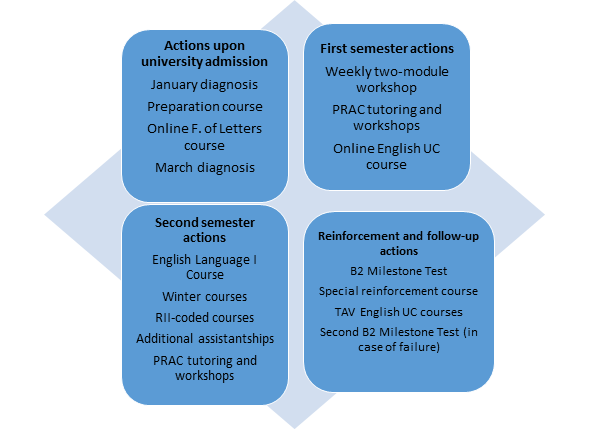What is it?
The Inter-faculty program of English Language Pedagogy for Primary and Secondary Education of the Pontificia Universidad Católica de Chile was created in 2017 and admitted its first group of students in 2018. Among the program’s objectives is to support the development of the English language in Chile and help close the gap in the use and command of the language in different school contexts. With this in mind, the decision was made not to have a required entry level of English, as per the inclusion policy promoted by the university.
This, then, has entailed the design of an English Language Leveling System, whose objective is to guarantee learning opportunities for those students in the program that were placed in lower achievement levels in the diagnostic assessment associated to competences 1 and 2 of the subject area described in the graduate profile.
This System includes activities that are designed and implemented by the English Language team from the Faculty of Letters, the Program Director and the English UC Language Center. The System’s activities are grouped according to the student’s curricular progress. This System, as well as any adjustments made to it, is reviewed and approved by the Curriculum Committee and the Program Council.

Assessment of leveling actions
The evaluation of the activities implemented under the English Language Leveling System has been positive, as they have shown to have an impact on students that have systematically accessed these learning opportunities. This is reflected not only in the fact that their English level has improved, but also in their positive comments about these activities. The actions that were best evaluated by the class enrolled in 2018 were the additional assistantship for the Applied Grammar I course in the second semester and the summer course after the B2 Milestone Test.
The devices designed are constantly reviewed and students are currently doing a halfway assessment of the activities designed for the first semester to allow for the necessary adjustments and to optimize resources.
The challenge is to encourage most students to use these opportunities and benefit from all these activities and actively commit to their own learning process. The evidence gathered helps to determine these activities’ efficacy, but we would like to increase the number of students that make use of them, given that, so far, it has been a reduced group.